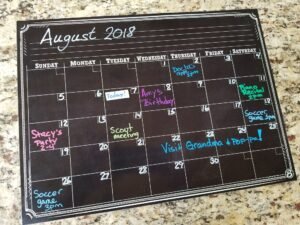Autism, or ASD, is a condition where your brain works differently. Each person with autism has a unique experience with it, to the point where I hesitated to write this post. For every child who is neurodiverse, there will be tips and tricks that sound good to some but not to all. In everything I write, I hope you, dear reader, will take what you need and leave the rest, and none more so than this particular post. However, I do think that I can offer some good ideas to make your homeschool days go better.
Without further ado, my 8 tips for homeschooling when your child has Autism.
1. Post a calendar for events and appointments.
 Children with autism often experience the world as unpredictable and uncomfortable. By creating a wall calendar filled with all of your important weekly events (dance, soccer, scouts, and co-op) and adding to it things like dentist appointments, trips, and other out-of-the-ordinary events, your child will be better able to prepare themselves for their day and week.
Children with autism often experience the world as unpredictable and uncomfortable. By creating a wall calendar filled with all of your important weekly events (dance, soccer, scouts, and co-op) and adding to it things like dentist appointments, trips, and other out-of-the-ordinary events, your child will be better able to prepare themselves for their day and week.
Make a point of marking off days or moving a counter to the correct day, so that your child has no trouble finding what is on today’s agenda.
2. Create a weekly and daily rhythm or pattern, that your child can expect.
Many autistic people thrive on having a routine. In your homeschool planning, this may mean doing the same subjects in the same order every morning, or it may mean having a regular rotation: Every Monday you do art and poetry tea time. Every Tuesday and Thursday you do math and science. Wednesday and Friday are language arts and history.
If you find your child gets upset about the routine you have planned, go back to the drawing board to make one that will work. Be sure to talk to your child about tweaks to the routine in advance.
3. Work with your child’s sensory needs.
For many autistic people, the world is literally uncomfortable all the time, as they experience sensory processing differences. Providing positive sensory input while they work can often help a child focus and participate better.
 Holding a weighted toy, like this dolphin, or allowing it to lay on them, can help ground a child and make them feel calmer during lessons. There are many weighted toys and blankets to choose from, in a variety of weights. Choose a toy that weighs between 5 and 10% of your child’s body weight, and plan to use it for less than an hour at a time. I find most of the time, children will naturally set the toy aside during lessons when they are feeling calm. A weighted toy may be especially helpful during lessons that your child finds challenging. For example, if math tends to upset them, that is a good time to pull out your weighted friend to join your class.
Holding a weighted toy, like this dolphin, or allowing it to lay on them, can help ground a child and make them feel calmer during lessons. There are many weighted toys and blankets to choose from, in a variety of weights. Choose a toy that weighs between 5 and 10% of your child’s body weight, and plan to use it for less than an hour at a time. I find most of the time, children will naturally set the toy aside during lessons when they are feeling calm. A weighted toy may be especially helpful during lessons that your child finds challenging. For example, if math tends to upset them, that is a good time to pull out your weighted friend to join your class.
Make your homeschool time even more comfortable by allowing your child to wear pajamas, listen to or read aloud books in bed or on a comfy couch or chair, and have soft or natural light and gentle music playing during lessons. If your child’s sensory system is comfortable, they should be better able to focus on lessons and learning.
4. Follow their passions when you can.
Many children develop an obsession, a thing they want to talk about, learn about, and explore, regardless of your lesson plans. Frequent topics for obsessions include trains, dinosaurs, wars, insects, and Minecraft. If your child is loath to put away their obsession, use it to your advantage. You can find whole unit studies and teacher resources on any of those topics and more with a quick Google search.
An obsession can be a great reason for your child to try reading new books or writing a story or blog about their interest (you can take dictation for younger students). Obsessions can lead us to try a new craft or activity or go on a field trip to learn in a different environment. All of these opportunities help to stretch your student’s understanding of the world and their own skills, even if it seems like they are only learning about one thing. Interest-led learning leads to a deeper understanding of the material, and that is a good thing.
5. Learn through unit studies.
 Unit studies work well for many children with ASD because it allows them to think deeply about a single topic and not have to make uncomfortable transitions to a different subject. A good unit study can include lessons in science, history, practical math, language arts, and fine art, all in a single context.
Unit studies work well for many children with ASD because it allows them to think deeply about a single topic and not have to make uncomfortable transitions to a different subject. A good unit study can include lessons in science, history, practical math, language arts, and fine art, all in a single context.
All of the lessons in our programs are unit studies designed to work well for children who don’t want to switch between separate books for each subject. Even the curriculums designed for younger children are designed to be a set of unit studies where you do one unit each week. However, there are many other unit studies available on a wide variety of topics. You may choose to alternate units that focus on topics in science, history, and literature, to cover a wider variety of topics over the course of your school year.
6. Don’t neglect your child’s strengths while working on addressing their weaknesses.
One of the pitfalls of homeschooling a child with learning challenges is that you can get too wrapped up in your child’s weaknesses and forget to foster their strengths. Make a list for yourself of ways to support your child in both their weaknesses and their strengths, and be sure to do some of each every week. This is hard, I know. It is easy to focus a lot of your energy on one or the other. Carve out a little time for your child to work on handwriting or verbal skills each week, or whatever weaknesses they have. Then make sure your schedule has time for their giant building project in Minecraft, or to watch that science documentary they are interested in.
Not every strength has to be academic. But it is important that you take time to do things with your child that they see themselves as good at. Cook dinner together, play board games, whatever they enjoy. Finding balance is key for everyone’s happiness. A happy homeschool makes a happy life.
7. Make time to practice life skills every day.
 The opportunity to do life skills each day with your child may be both the greatest gift and the most frustrating part of homeschooling a child with ASD. Due to sensory issues or processing challenges, life skills such as bathing, dressing, cooking, cleaning and other chores often happen later for children with ASD. They need more help to learn to do these things on their own. But these skills are essential to being happy, self-sufficient adults. So carve out a little time each week to work on them.
The opportunity to do life skills each day with your child may be both the greatest gift and the most frustrating part of homeschooling a child with ASD. Due to sensory issues or processing challenges, life skills such as bathing, dressing, cooking, cleaning and other chores often happen later for children with ASD. They need more help to learn to do these things on their own. But these skills are essential to being happy, self-sufficient adults. So carve out a little time each week to work on them.
Go slowly. If your child tends to resist helping with household tasks, try to choose ones they are interested in or will be successful with. Most children cannot resist helping when you state they need to bake brownies today for part of school. And for some reason, using the squirt bottle and cleaning the insides of the windows has been a favorite simple chore for all of my children.
8. Celebrate all your child’s achievements and successes, plus your own.
When your child has a great day, writes their name or first sentence, or learns a new skill, celebrate that. Create your own tradition. It could be baking cookies, getting a small treat like stickers or having a FaceTime visit with grandma to share your excitement.
As a homeschool parent, celebrate those achievements too, but also reward yourself for getting through the hard days, too. Hide your own stock of chocolate, or bath bombs to have on the days when you know you deserve a prize for getting through a day full of meltdowns and challenges. Reward yourself with a grown-ups only TV show while your spouse manages the children. You are doing hard work! Give yourself the recognition you deserve for all that you do.





0 Comments